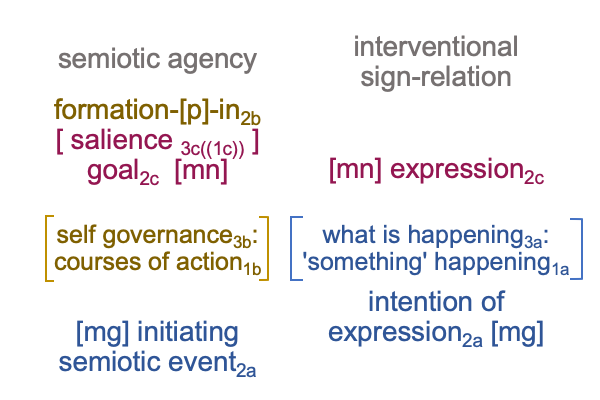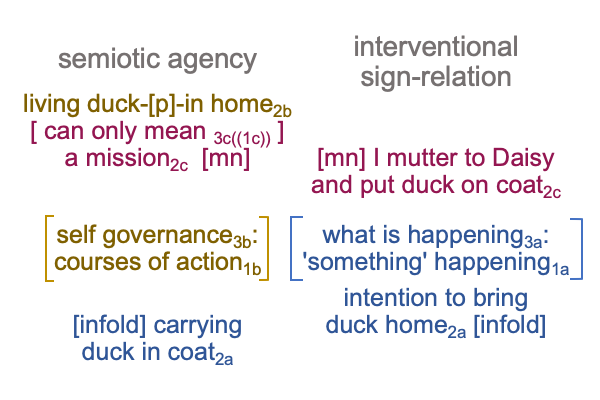1031 Have I avoided the author’s epistemological trap (section 8.2)?
Does what I am saying (SVi) seem to support what I think (SOe)?
At least, to a disinterested observer (SOi)?
1032 What am I wrestling with?
Here is a picture, relying on a combination of elements from Sharov and Tonnessen’s noumenal overlay and from the scholastic interscope for how humans think.

1033 I now proceed by way of example.
1034 I say to Daisy, “I guess that we are taking this duck home in order to see whether it lives.”
My expression2c (SVi) stands for my intentions in making the statement2a to Daisy (SOi) in regards to what is happening3a operating on the fact that ‘something’ has happened1a (SIi). Daisy got what she wanted. The other dog did not. And now, I am Daisy’s master and assigned to make sense of this disaster. I suppose that is why humans make such good pack-leaders for these domesticated wolves.
1035 I take off my waterproof jacket, toss inside down onto the ground, then place the still-breathing remains on the tarp2a (SVs). The duck is not as heavy as I anticipated. It is easy to carry home, even with Daisy on the leash and constantly wanting to check on it2b (SOs). The duck is the “form” in “information2b” (SOs). Its presence is contiguous with the… “in- “… of “information2b” (SVe). Yes, I am in it2c (SOe) alright. So, is Daisy and the ornamental duck who is seriously messed up.
1036 Daisy suspects what I am going to do2c (SOe) because I did the same for her.
Her suspicions make information2b pertinent, because it2b is bound to be salient3c((1c)) to our goal2c.
1037 My written description of Daisy’s suspicions runs right into section 8.3 titled, “The Observer, the Observed, and the Problem of Interpretation”.
Would a biosemiotician say that he (or she) can observe and measure the sign-vehicles and the sign-objects in the following diagram?

1038 Yes, the SVs and the SOs become phenomena once the biosemiotic noumenal overlay is regarded as the thing itself. My particular episode may serve as a case study. See any article in The Journal on the Care of Injured Ducks.
Daisy is not cognizant that I plan (SVe) work up a case study to submit for publication.
Publish or perish!
1039 Is this where the author is taking this examiner?
Yes and no.
Yes, there is an epistemic cut between an organism’s observed adaptive response (SVi) and an observer describing the adaptive response in terms of sign-elements and claiming that an interpretation is plausible (SOi). It seems as if what is plausible (SOe) derives from a sign-object (SOs) that all biological processes and entities have in common.
No, the epistemologist cries, “Cut!”
1040 Then, members of the audience look around asking, “Who said that?”
The heckler shouts, “I mean… cut between semiotic agency and the interventional sign-relation.”
Then, the well-certified members settle back in their chairs and cluck, “Yes, it is epistemic.”
Take a look at “yes” and see that the cut is incorrect.
